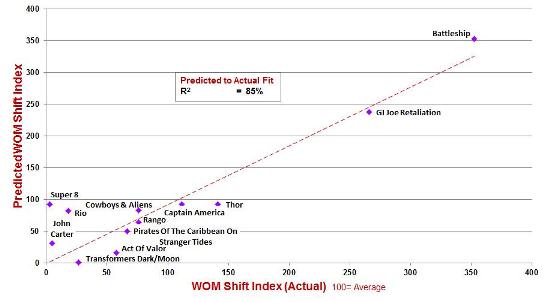How to Maximize A Super Bowl Ad's Word of Mouth – Part 2 - Graeme Hutton-UM

This time last year, I described in mediabizbloggers.com how a Super Bowl ad's word of mouth volume could be demonstrated to be dependent upon both the creative message and certain critical media factors. This year, I repeated the study by probing two years of combined data to see if a macro-trend would emerge. The short answer: Yes, it does.
This time last year, I described in mediabizbloggers.com how a Super Bowl ad's word of mouth volume could be demonstrated to be dependent upon both the creative message and certain critical media factors. This year, I repeated the study by probing two years of combined data to see if a macro-trend would emerge. The short answer: Yes, it does.
The Super Bowl remains the most watched annual TV event in the United States – on average over 40% of all homes watch each year. It's not so much a TV show as a major cultural phenomenon. Its advertising devotees, with some justification, will point to how each game is different. How the game unfurls, especially the ebb and flow of tension quarter by quarter, will be the prime, and unknown, determinant of the best position for an ad.
Last year, I built a multiple regression model of the 2011 Super Bowl by combining two separate data sources, Kantar and The Keller Fay Group. The aim was to determine the extent to which an advertisement's lift in its word of mouth during the week after the game could be attributable to any media factors. Revisiting this study, I added the comparable data for 2012. From Kantar, I looked at each ad's Nielsen audience rating and other key information such as quarter and position in pod. From Keller Fay, I sourced each ad's word of mouth data from their custom Super Bowl Talk Track study.
To eliminate both market category and brand awareness legacy biases, I focused solely on movie advertisers. The movie marketing category is truly unique. Each movie's launch represents a new and distinctive brand franchise, reducing the image 'baggage' that many long standing brands might have – especially, if they have repeatedly advertised in the Super Bowl over several years.
The modeled relationship between the predicted and actual word of mouth across both years produced a fit (r-squared to use the jargon) of 85%. The relationship can be shown graphically as follows:

The two primary factors that impacted the WOM score were: a) the 18-54 Adult rating, and b) the quarter in which the ad appeared. Not surprisingly, the higher the Nielsen TV rating, the higher the Keller Fay WOM score. In terms of quarter, we saw a pattern which indicated that in general, the earlier in the game the better. The model also indicated that, in general to some degree, being last in pod was also seen to be influential, although less so than the other two factors. However this varied by year: looking at 2011 alone, being first in pod was more valuable, although last in pod was more valuable than being in the middle position. Also of note in 2012, Battleship, a Universal movie, was featured in a :60, and while this was just a one-off across the two year study, it did seem to lift the film's overall word of mouth volume. Last year, doubts were cast on the value of accompanying billboards at the beginning or end of a pod (the short voice-over announcements proclaiming "This portion of today's program was brought to you by… ") and this year's data did nothing to dispel that uncertainty.
What did surprise me was how the data was so consistent year over year. I really thought that I would have to build a model which made adjustments year on year for differences in TV audience levels and word of mouth intensities, but there was a near perfect match in each of these data set. Indeed, when I did input any potential annual adjustment factor in to the model, it actually made the result worse! This is a testament to the stability, robustness and quality of the data from both Nielsen and Keller Fay.
Yet despite the clear results from this model and other key work in this area, I think the heated debate of whether or not to advertise in the Super Bowl will continue unabated. Advertising in the Super Bowl has both its champions and its detractors. Looking at all Super Bowl advertisers, the one point I can see is that merely appearing in the Super Bowl is no guarantee at all that your word of mouth will surge ahead. For any Super Bowl advertiser, specific game research, such as Keller Fay's, will continue to be critical in understanding which brands are this year's real Super Bowl champions.
Graeme Hutton is SVP, Group Partner, Research at UM. Graeme came from the UK to the US in the late 90s, and his only regret is that he did not do it sooner! Graeme joined UM in 2006. At UM, he has engineered and activated a broad-based set of integrated communications and consumer insight tools which dovetail in to the agency’s burgeoning arsenal of media research products and systems. His key clients include Sony Pictures Entertainment and Sony Electronics. Graeme can be reached at Graeme.hutton@umww.com
Read all Graeme's MediaBizBloggers commentaries at Curious Thoughts from Curious Minds.
Check us out on Facebook at MediaBizBloggers.com
Follow our Twitter updates @MediaBizBlogger
The opinions and points of view expressed in this commentary are exclusively the views of the author and do not necessarily represent the views of MediaBizBloggers.com management or associated bloggers. MediaBizBloggers is an open thought leadership platform and readers may share their comments and opinions in response to all commentaries.


